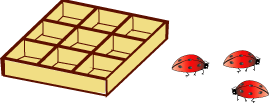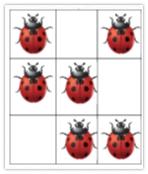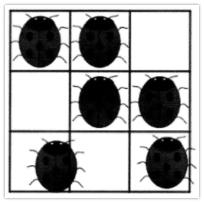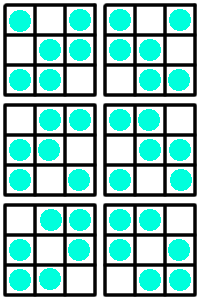Ladybird box
Place six toy ladybirds into the box so that there are two ladybirds in every column and every row.
Problem
Some toy ladybirds are kept in this box which has 9 little square compartments.

Can you place six ladybirds into the box so that there are just two ladybirds in every column and every row?

Getting Started
If you are not using the interactivity, it would help to have six counters and a $3$ by $3$ grid drawn on squared paper. Or you could print out this sheet.
Student Solutions
We had just a few submissions for this activity but they show a variety of solution systems.
Liva and Maya from the International School of Latvia sent in the following:
We solved the ladybird box problem. We both solved it without knowing the other one did too. Then we got together and talked about it.
Liva: So first I read the instructions. I tried some ways online, but it didn't work so I read the instructions again and it didn't say that the ladybirds can't be three diagonally, so I put all six randomly.
Then I put all the ladybirds that fit only the first instruction - two ladybirds in every column.
Then I tried to put them so they fit the second instruction.
After that I put only five - top right corner, top left corner, exact middle, bottom left and bottom right corner.
Then I saw that in the middle row was only one ladybird so I put the sixth ladybird next to the middle one and then I moved left bottom one space to right, because I knew about now they fit in every row and column.
Then I counted... Six! And it fits the instructions!!!
Maya: So first I read the instructions. It said that I have to put them in with only two in each column and row but it never said diagonally, so I started on the first column and put two going down.
Then I went to the second column and put two on the bottom going up.
Then the last two spaces that would work were the top and bottom squares on the last column.
Then I looked at the last words. 'Can you find different ways of doing it?' Yes! Just put it upside down! So that's how I solved the ladybird problem!

Jimmy from the Crescent Head Public School in Australia sent in the following:
I used counters to figure it out. I made a few mistakes at the start but once I got the hang of it I didn't need the counters.

Thomas spoke to his Granny who wrote down what he said:
"I put two in the first row then two in the second row. I saw one column with one ladybird and a row with one so I moved the last ladybird until there were two."

David from Histon Junior School said at first he couldn't do this problem. But when he'd found one way to place the ladybirds, he kept finding more and more!
Well done!

Thank you for these. I hope you'll send in solutions to other activities soon.
Teachers' Resources
Why do this problem?
This problem requires both spatial and number understanding. It fits well with work on pairs and counting by twos. To understand the problem, the children will need to be comfortable with the idea that the $3$ by $3$ grid represents a top view of the nine-hole box. They will also need to be familiar with the meaning of rows and columns. The problem provides a good opportunity for developing positional language and utilising ordinal numbers. For example: "I put a ladybird in the middle of the second row" or "Go across three then down one". It is also a good context in which to discuss what makes one solution different from another.
Possible approach
Key questions
Which row and which column can still have a second counter/ladybird?
Possible extension
Children could be encouraged to find all possible solutions and explain why they are sure they have found them all.
Possible support
You could encourage children to start by placing just four counters then seeing which row and which column have less than two counters in them.
